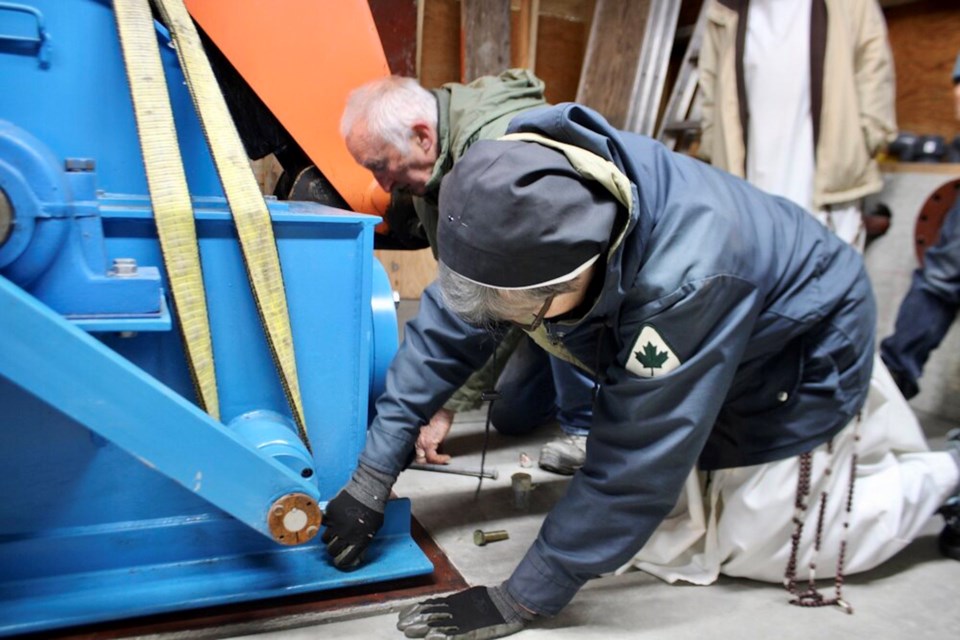Unless you’re looking for it, you wouldn’t even know it’s there.
Down in the Squamish Valley, on a sprawling 82-acre tract of land nestled beneath Cloudburst Mountain, stands the Queen of Peace Monastery. There are currently 13 sisters that reside there, and for the last decade, these industrious nuns have been working to construct a sustainable hydroelectric system on the Pilchuck Creek, the waterway that runs through their property. And now that construction is complete, project manager Peter Talbot said it’s so expertly camouflaged into the surrounding foliage that the average passerby would completely miss it.
“I remember when we first went up there to the site, I said ‘when this is done, it will be a little emerald, a green oasis of renewable power that’s the only one in the Squamish Valley’ and looking at it now, that’s exactly what it is. It’s a shining light of clean, quiet power for the monastery and the whole valley,” he told The Squamish Chief.
Construction was completed in the fall of 2021.
“I’ve had people go look at it, engineers, and they’re amazed by how simple it is and how it blends into the scenery. It’s like a work of art. You would never even see it unless you walked right up to it. We were really fortunate because the system went in easily and we hardly had to do any work whatsoever as far as clearing land. We cut down a few alder trees, moved a few stones, that’s it.”
The electricity generated by the Pilchuck Creek current will allow the nuns to live entirely off the grid, using their own electricity and sharing what they don’t need. Though he’s worked on dozens of other projects, Talbot considers the system to be his proudest accomplishment — and definitely one of the most unique, as he’d never worked alongside Dominican nuns before.
“Their work ethic is perfect. When we needed help digging or hauling, they were right there, ready to jump in. They’re delightful to work with, and especially the younger ones are tough as nails. They would get right down in the river to split rock and carry cement and haul pipe and it was wonderful to see them get down and dirty on the job.”
Caring for creation
When people think of Dominican nuns, sustainability may not be the first thing that comes to mind. But according to Sister Claire Rolf, being mindful of humanity’s impact on the environment and trying to live more sustainably aligns with their Catholic mission. Embarking on a hydroelectric project may seem like an incongruent activity for a bunch of nuns, but it’s in line with their entire mission, which includes a vow of poverty.
“We wanted to contribute to making our footprint smaller in this world. It just made sense to contribute to caring for our creation, for the earth this way,” she said.
“We love it when people come and pray or sit in our chapel, because it’s so beautiful here that people really get to love creation and find ways of standing up for it, and make sacrifices for it, to relieve the world of its stress because of course our planet is under a great deal of stress.”
According to her, they’re not the only monastery worldwide looking to lower its environmental footprint, and this project may well inspire other communities to pursue similar endeavours in the face of the ever-growing climate crisis. They already practice reusing and recycling, and share a car among multiple adults. The hydroelectric project was simply the next step.
The nuns’ initial plan for the system was more ambitious than the one they ultimately settled on, because as they studied the geography and crunched the numbers, they decided to cut back the desired electrical output to closer match their needs. They did not want to be producing excess energy if they could help it. Now that they’ve weathered their first winter, they have a better idea of how that’s going to work.
“The system is quite small. We feed the grid, but there’s times when we’re off grid. We won’t be running it in the hot season, because we want to keep the creek running and protect the habitat. So we pay for our electricity and then in the winter, we feed the grid, so it works out pretty even. It will take years and years to ever pay for it,” she said.
“But we’ll be breaking even and our expenses will be less. We wanted to be a sustainable community, and this brings us closer to that goal.”
Looking back on what they’ve accomplished, Rolf feels they couldn’t have finished without the support and hard work of their neighbours, community members and volunteer experts. She said it was a beautiful moment when they all finally got to see the finished project in operation.
“We’re so grateful that the project is finished, and now we’re learning how it operates. One day they pressed the button and suddenly we were on the creek rather than the grid. It was a great moment.”




